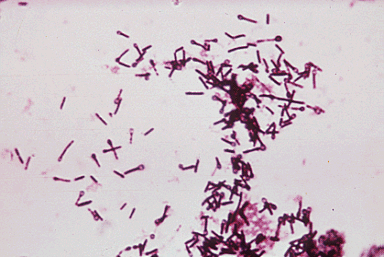By Kurt Kiefer


Clostridium tetani is a bacteria that causes tetanus in humans. Tetanus is a condition also referred to as lockjaw. Clostridium tetani are Gram-positive, spore-forming rods that are anaerobic. If they enter the body through a wound, they can multiply and produce a toxin that effects the nerves and controls the activity of muscles.
C. tetani spores can be acquired from any type of injury involving an infected device. Being punctured by a rusty nail is a common the source of an infection, but infections can also occur from a wound, a burn, an ulcer, a compound fracture, operative wounds (aquired during operations), or a drug injection. If an anaerobic environment is present, the spores will germinate and form active cells.
If not treated early, the death rate of C. tetani is high. After being infected, the first sign is a lesion in the skin that is usually not noticed. The Spores germinate, and the new cells release a toxin called tetanospasmin. Usually it will lie dormant for a few days to weeks, but the shorter the incubation period, usually the higher the mortality. The muscles will begin to intermittently contract around the site of entry. The toxin then passes retrograde along nerve fibers, and fixes to nerve tissue. The toxin's main target is the area around the brain stem. Lockjaw occurs and is followed by general rigidity of the body, then muscle spasms occur throughout the body. Finally, death is caused by interference with muscles required for breathing. Luckily it is usually prevented through immunization, so not that many cases occur. Each year, 200 cases occur in US, with 350,000 cases occuring per year worldwide. Although C. tetani itself can be treated easily with penicillin, but this will not destroy or neutralize the toxin. Antibodies to the toxin can bind to and inactivate the toxin before it attacks muscles and nerves, though.
Immunization is the best way to prevent C. tetani infections in children and adults. The process is started early with the first four shots being administered within two years of birth. The first shots are followed up with booster shots given every ten years.
Bibliography:
http://medic.uth.tmc.edu/path/00001496.htm
http://www.microvet.arizona.edu/courses/mic420/lecture_notes/clostridia/clostridia_neurotox/c_tetani.html
http://drreddy.com/shots/tetanus.html
Return
to Bacterial Disease Page